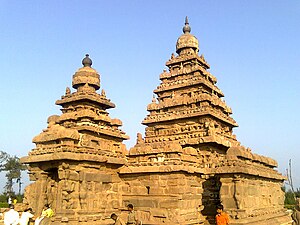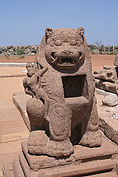Shore Temple
| Shore Temple | |
|---|---|

Shore Temple Complex
|
|
| Geography | |
| Coordinates | 12°36′59″N 80°11′55″E / 12.61639°N 80.19861°ECoordinates: 12°36′59″N 80°11′55″E / 12.61639°N 80.19861°E |
| Country | India |
| State | Tamil Nadu |
| Location | Mamallapuram or Mahabalipuram, District Kanchipuram |
| Culture | |
| Primary deity | Shiva |
| Architecture | |
| Architectural styles | Dravidian architecture |
| History and governance | |
| Date built | 700–728 |
| Creator | Narasimhavarman II, Pallava dynasty |
| Shore Temple, Mahabalipuram | |||||||
|---|---|---|---|---|---|---|---|
| Shore Temple of Mahabalipuram
UNESCO World Heritage Site |
|||||||

Shore Temple of Mamallapuram (Mahabalipuram) (700–728 AD)
|
|||||||
|
|||||||
The Shore Temple (built in 700–728 AD) is so named because it overlooks the shore of the Bay of Bengal. It is a structural temple, built with blocks of granite, dating from the 8th century AD. It was built on a promontory sticking out into the Bay of Bengal at Mahabalipuram, a village south of Chennai in the state of Tamil Nadu in India. At the time of its creation, the village was a busy port during the reign of Narasimhavarman II of the Pallava dynasty. As one of the Group of Monuments at Mahabalipuram, it has been classified as a UNESCO World Heritage Site since 1984. It is one of the oldest structural (versus rock-cut) stone temples of South India.
Shore temple is a complex of three temples, one large and two small, located right on the shores of the Coromandel Coast of the Bay of Bengal in Mahabalipuram, which was earlier known as Mamallapuram. During the Pallava Dynasty reign this was a port city of their kingdom which they ruled from Kanchipuram. It was built by the Pallava Dynasty when it was the trading port of the dynasty.
Sailors gave the name Seven Pagodas to the Shore Temple when they saw this tall structure on the seashore, as the temple probably acted as a landmark for navigation of their ships. As it appears like a Pagoda, the name became familiar to the seafarers.
This structural temple complex was the culmination of the architectural creations that were initiated by the King Narasimha Varma I (popularly called as Mammalla after whom the Mamallapuram town is named), in mid 7th century starting with the Cave temples and the monolithic Rathas. Even though the architectural creation of sculpturing cut-in and cut-out structures continued during subsequent periods, as seen in the Atiranachanda cave, the Pidari rathas and the Tiger cave, the main credit for the architectural elegance of the Shore Temple complex in the category of structural temples goes to the King Rajasimha (700–28 AD), also known as Narasimhavarman II, of the Pallava Dynasty. It is now inferred that this temple complex was the last in a series of temples that seemed to exist in the submerged coastline; this is supported by the appearance of an outline of its sister temples off the coast during the Tsunami of 2004 which struck this coastline. The architecture of the Shore Temple was continued by the Cholas (in the temples that they built) who ruled Tamil Nadu after defeating the Pallavas.
...
Wikipedia







